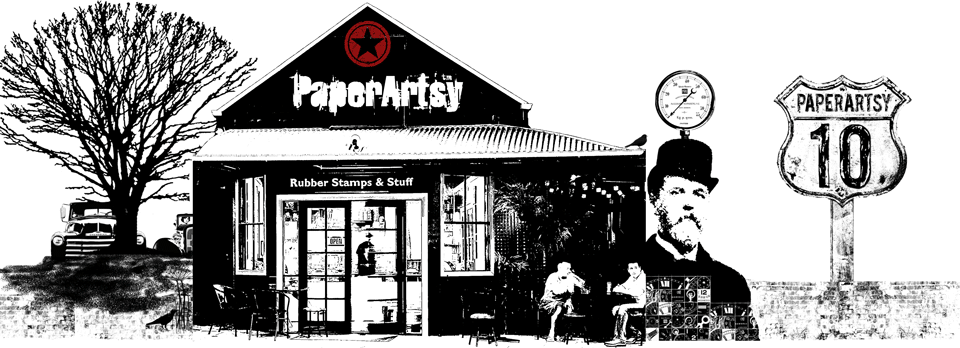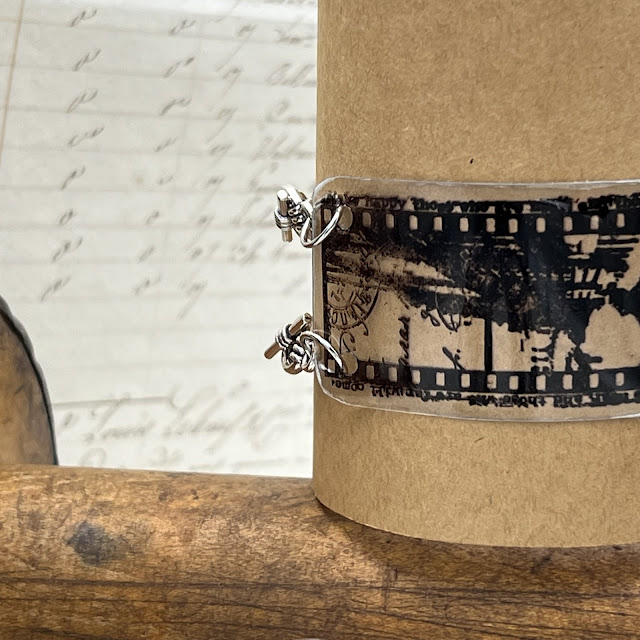Hi everyone, it is Ann ( aksbarchitect CREATES) here with you. I have been really enjoying all of the vintage PaperArtsy projects lately. What a wonderful celebration to be a part of! I am excited to share my project for the this PaperArtsy topic with you today.
The Vintage PaperArtsy concept had me thinking about ways of using the incredible vintage style images in a contemporary way. Exploring new methods and mediums is something I love to do, so I decided I would try my hand at making a modern jewelry piece with resin; a clean and simple design that will allow the image to be the main focus. I learned a lot with this project, especially when it came to stamping on non-porous surfaces.
While the process was definitely a struggle for me, the modern filmstrip jewelry pieces turned out better than I had hoped, definitely showcasing the vintage stamped image in a contemporary light. I had thought that working with resin would be the most complicated part of the process- it turned out that my knowledge of ink types and stamping on nonporous surfaces would be the real hurdle.
I chose to use the PaperArtsy Minis stamp MN35 as the main image for my project. As much as I love using color in my artwork, when I imagined this project, the use of color never even entered my mind. I kept going back to the PaperArtsy theme for this quarter: Glazed. With the stamp image being a silhouette within a filmstrip, I always envisioned the colors from the external surroundings showing through the piece, making an accessory that would work with whatever someone was wearing.
The first step in any project I am working on is to familiarize myself with the supplies I will be using. If I am stamping, I like to do some test stamps, to ensure I know how to achieve the best results as well as to understand which inks will work best for my substrate. Initially, I stamped PaperArtsy Minis stamp MN35 on some text paper. This was my first time using this stamp so I wanted to prime the stamp, and create a reference for future use.
I want my bracelet to appear as if an actual filmstrip is encased in the resin. This means I need a crisp and opaque black stamped image. After my test stamping, the next step is to experiment on the clear acetate. I have a basic idea that working with either the Ranger Archival Ink, Tsukineko StazOn ink, or PaperArtsy Fresco Finish Chalk Acrylic paint (Little Black Dress, FF19) will give me the most opaque images, thus mimicking an actual strip of film negatives.
I will be using clear acetate as the base for my stamping. Acetate is non-porous, a very different finish from the text paper that I stamped on initially. I did a bit of research on the best inks for stamping on non-porous surfaces. It appears that any of the three mediums I selected should work. Since I have never stamped on Acetate before, I want to stamp some sample pieces to help me decide which black I will use on the final piece.
I stamped the image one time with each medium onto the acetate. As you can see, the Ranger Archival Ink(Black Soot) appears somewhat ghosted. I waited a long time for the ink to dry and even much later, the ink smeared. The image does not appear as crisp as it did in my initial test print. I will not be using the Archival Ink for my jewelry piece.
Next, I used a brayer to spread PaperArtsy Fresco Finish Chalk Acrylic (Little Black Dress, FF19) onto the stamp, then, using a stamping platform, stamped the image. I believe if I stamped repeatedly, I could achieve an opaque black on the acetate, however, the matte finish will not provide the look of a glossy strip of film. I will not be using the PaperArtsy Fresco Finish Chalk Acrylic paint for my piece.
Finally, I used the Tsukineko StazOn ink (Jet Black) Solvent ink and I was very pleased with the crispness, even though it seems I will need to do multiple passes to achieve a solid image. The black ink is opaque, glossy, and reminds me of how an actual film strip might appear. I waited for a long time after stamping and the ink dried on the acetate and did not smear. This will be the ink I will use for my piece.
I am both excited and a bit anxious about the next steps. The StazOn ink requires a bit of drying time so I will need to do the stamping in stages. I will also need to create more than one strip in case I have any problems with the resin.
I set up my stamping platform to make it easier to extend the single stamp image into an elongated strip of images. Using a different color ink to stamp the image onto a base paper will allow me to easily see which areas of the stamped image have not stamped completely since the acetate is clear. It will also help me align the images to create the continuous strip.
Right away I notice that this process is going to take even longer than I had originally thought. When stamping on the acetate, you need to wait for the first layer of ink to completely dry before stamping another layer. Since acetate is non-porous, the ink sits on top and if you re-stamp before the first layer is dry, it simply picks the first layer back up.I create a few extended strips of images and allow the first layer to dry. Then I reposition the strip and begin the process once again. I repeat this process at least three times. Even though the silhouette of the man never does quite fill in solidly, I think it gives it a vintage look. It is time to move on to creating the jewelry piece.
The strips of acetate were measured and cut to fit into a silicon cuff bracelet mold before they were stamped on. Once the ink has dried completely, I mix the Art Resin (resin and hardener) together according to the instructions and pour it into the mold. I then push the stamped acetate into the resin mixture.
The suspense in waiting for the resin to cure and hoping that it is crystal clear had me a little worried, especially after all of the effort to get the stamped images just right.
I decided to make some additional jewelry pieces from the resin coated strips. I made a set of earrings using a singular image for each. I punched a small hole at the top, then added jump rings and an earring hook. I think these will be a fun accompaniment to the cuff bracelet or even on their own!
Using one of the additional resin coated strips, I made double toggle clasp bracelet. This piece might be fun for a casual outing, or even just to run errands. I like the idea that it is a bit more flexible than the cuff. The remaining pieces will go into my art bin.
Even though I struggled with various steps creating this project, I enjoyed the process, and I believe that the jewelry will be a fun way to accessorize an outfit. Creating resin jewelry pieces could be done with any of the wonderful PaperArtsy stamp images. I have even considered masking within the filmstrip and incorporating different images to create an entirely different look.
Thanks for stopping by, I hope that maybe this has inspired you to pull out your supplies and create something.
-Ann
Blog: aksbarchitect CREATES
Facebook: Ann Sullivan Barnes
Instagram: @aksbarchitect

























3 comments:
Ann, this is so cool! I love the look and would really like to try this out! Thanks for the inspiration xx kaz x
So creative Ann. So the earrings and double clasped bracelet strips were made from resin strips. Was the resin painted on with a brush?
Beautiful jewellery made by you. Especially your idea to use silicon cuff bracelet mold. Love them all Ann. xx
Post a Comment